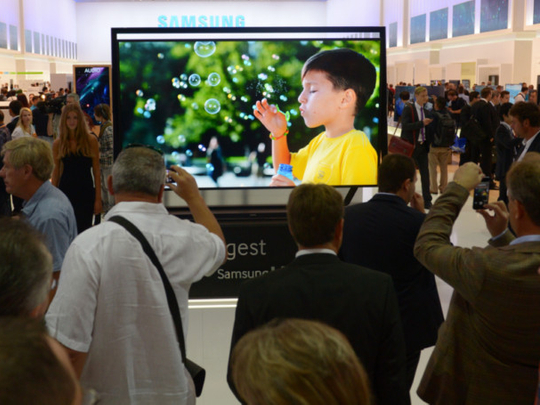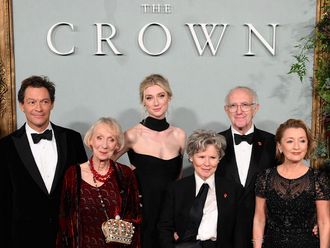
Televisions are increasingly looking like oversized cousins of phones — they get smarter, use similar platforms, run a bunch of apps, connect to social networks, stream from YouTube, bring in news and play games. Some TVs even do video calls. As Paul Gray, a director at NPD DisplaySearch, a company that deals in display market research, notes, “With broadcast requirements static for the time being, innovations in TV capability have instead been for internet services and interactivity: smart TV. These have brought a convergence of functions between TVs, tablet PCs and smartphones. A high-end TV really is a large-screen smartphone!”
But one critical difference exists: the frequency with which consumers replace the devices. Users in the UAE love smartphones, being among the world’s most prolific upgraders. But the upgrade cycle for smart TVs is still counted in years, not months. As NPD DisplaySearch found out in its TV Replacement Study, TVs are typically replaced after six to eight years on an average, while users replace smartphones every two years. The biggest issue is the price difference between the two.
That means TV manufacturers have to work extra hard at convincing you to dump your two-year-old TV and switch to the latest. This is typically done by tempting you with must-have features. While ideas such as the 3D TV have fizzled out, others such as curved displays may remain niche. The current hope however is ultra-high definition or HD, popularly known as 4K. Count on it to be the most marketed term in TV tech this year and next. Research firm Dataxis, in its 4K TV Market and Forecasts (2013-2018), says there will be 2.2 million 4K TV households by the end of 2013, climbing to 66.2 million by the end of 2018. The Asia-Pacific region will emerge as the biggest market accounting for 42 per cent of global 4K TV households. Overall, global shipments of 4K TVs will exceed by 5 per cent of the total annual TV shipments in 2017, while the installed base of 4K TVs in Europe, North America and mature Asian markets will also touch 5 per cent by 2018.
However, NPD DisplaySearch is more conservative in its estimates. Early this year, it predicted more than half a million 4K TVs would ship worldwide this year, climbing up to more than seven million by 2016.
Healthy growth
Overall, most experts foresee healthy growth in the smart TV market, driven primarily by maturing technology and sliding prices. Research and Markets, a market intelligence agency, forecasts the global smart TV market to grow at a CAGR of 18.2 per cent over 2012-2016.
And the Middle East and North Africa (Mena) region is expected to represent a healthy chunk of this market, with an audience profile that is willing to experiment with new technology. According to Informa Telecoms & Media, a part of research firm Informa, almost 60 per cent of Mena inhabitants are under the age of 35, a statistic that helped “shape the popularity of certain content types” on TVs. As a press release from Informa adds, connected TV is rapidly evolving in the Mena region with providers, broadcasters and manufacturers such as STC, OSN and Samsung offering consumers increased access to content through smart devices. The proliferation of connected devices is, in turn, “fueling demand for OTT, cloud and multiscreen services in Mena, and is expected to dramatically increase over the next five years.”
However, while the larger connected devices category will grow rapidly in Mena — Informa reports tablet sales will jump from 6.5 million in 2012 to 32.1 million in 2016 — and globally, smart TVs will have to face tough competition mainly from cheap and hence easily disposable smart devices such as Google Chromecast and Android Stick PCs, plus smart video streamers and connected boxes such as the Roku. Cautions Barbara Kraus, Director, Research, Parks Associates, “Innovations such as next-gen game consoles and 4K or ultra-HD TVs will boost unit sales for these devices, but overall, consumers are reluctant to replace these big-ticket items solely for smart upgrades.”
Lack of knowledge
Many consumers also don’t exploit the advantages of their smart TVs, so convincing them to buy a new one with more features becomes a tough sell. As research site BuddeComm.com explains, “While we are great believers in the potential of smart TV, we don’t foresee the revolution is going to come out of the current generation of this technology because many of the functions offered by smart TVs are not even being used by consumers yet.”
Echoing this, research firm YouGov’s Connected TV Tracker revealed in May that in the UK, 13 per cent of the population owned a smart TV in the first quarter of 2013, but less than 6 per cent used it as a primary source for online content. Says Dan Brilot, Media Consulting Director at YouGov, “Many people who buy smart TVs seem to be largely unaware of the capabilities offered. For TV manufacturers to gain traction in this area, they need to showcase what their devices are capable of and offer them as something distinct from set-top boxes and other internet-connected kit.”
The path to smart TV success seems to have two lanes – educating consumers on why buying one is a smart idea and fending off competition from cheaper smart devices with killer hardware tech such as 4K. And yes, there is an 8K around the corner as well.












